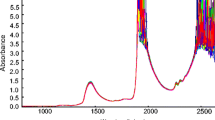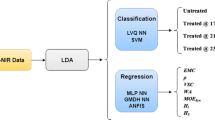Abstract
The visible/near-infrared spectrum consists of overtones and combination bands of the fundamental molecular absorptions found in the visible and near-infrared region. The analysis of the spectrum might be difficult because overlapping vibrational bands may appear nonspecific and poorly resolved. Nevertheless, the information it could be retrieved from the analysis of the spectrum might be very useful for the food industry producers, consumers, and food distributors because the meat could be classified based on the spectrum in several aspects such as the quality, tenderness, and kind of meat. This paper applies Mutual Information theory and several classification models (Radial Basis Function Neural Networks and Support Vector Machines) in order to determine the breed of pork meat (Iberian or White) using only as input the infrared spectrum. First, the more relevant wavelengths from the spectrum will be chosen, then, those wavelengths will be the input data to design the classifiers. As the experiments will show, the proposed techniques, when applied with a correct design methodology are capable of obtaining quality results for this specific problem.

Similar content being viewed by others
Explore related subjects
Discover the latest articles, news and stories from top researchers in related subjects.References
Boser BE, Guyon IM, Vapnik VN (1992) A training algorithm for optimal margin classifiers. In: COLT ’92: Proceedings of the fifth annual workshop on computational learning theory, ACM, New York, NY, USA, pp 144–152
Brøndum J, Munck L, Henckel P, Karlsson A, Tornberg E, Engelsen SB (2000) Prediction of water-holding capacity and composition of porcine meat by comparative spectroscopy. Meat Sci 55(2):177–185
Broomhead DS, Lowe D (1988) Multivariate functional interpolation and adaptive networks. Complex Systems 2:321–355
Busk H, Olsen EV, Brøndum J (1999) Determination of lean meat in pig carcasses with the autofom classification system. Meat Sci 52(3):307–314
Bonnlander BV, Weigend AS (2004) Selecting input variables using mutual information and nonparametric density estimation. In: Proceedings of the ISANN, Taiwan
Chih-Chung C, Chih-Jen L (2001) LIBSVM : a library for support vector machines. http://www.csie.ntu.edu.tw/∼cjlin/libsvm
Cozzolino D, Murray I (2004) Identification of animal meat muscles by visible and near infrared reflectance spectroscopy. Lebensmittel-Wissenschaft und-Technologie 37:447–452
Geesink GH, Schreutelkamp FH, Frankhuizen R, Vedder HW, Faber NM, Kranen RW, Gerritzen MA (2003) Prediction of pork quality attributes from near infrared reflectance spectra. Meat Science 65(1):661–668
Guillén A, Rojas I, González J, Pomares H, Herrera LJ, Fernández F (2006) Multiobjective RBFNNs designer for function approximation: an application for mineral reduction. In: Proceedings of the ICNC06 Conference, 4221:511–520
Guillén A, Rojas I, González J, Pomares H, Herrera LJ, Prieto A (2006) A fuzzy-possibilistic fuzzy ruled clustering algorithm for RBFNNs design. Lect Notes Comput Sci 4259:647–656
Guillén A, Rojas I, González J, Pomares H, Herrera LJ, Valenzuela O, Prieto A (2005) A possibilistic approach to RBFN centers initialization. Lect Notes Comput Sci 3642:174–183
Guillén A, Rojas I, González J, Pomares H, Herrera LJ, Valenzuela O, Prieto A (2005) Improving clustering technique for functional approximation problem using fuzzy logic: ICFA algorithm. Lect Notes Comput Sci 3512:272–280
Guillén A, Rojas I, Ros E, Herrera LJ (2005) Using fuzzy clustering technique for function approximation to approximate ECG signals. Lect Notes Comput Sci 3562:538–547
Harald S, Alexander K, Sergey AA, Peter G (2004) Least dependent component analysis based on mutual information. Phys Rev
Herrera LJ, Pomares H, Rojas I, Verleysen M, Guillen A (2006) Effective input variable selection for function approximation. Lect Notes Comput Sci 4131:41–50
Jun Q, Ngadi M, Wang N, Gunenc A, Monroy M, Gariepy C, Prasher S (2007) Pork quality classification using a hyperspectral imaging system and neural network. Int J Food Eng 3(1):1–12
Kraskov A, Stgbauer H, Grassberger P (2004) Estimating mutual information. Phys Rev
Ortiz-Somovilla V, Espaa-Espaa F, Gaitán-Jurado AJ, Espaa-Espaa J, De Pedro-Sanz EJ (2007) Proximate analysis of homogenized and minced mass of pork sausages by NIRS. Food Chem 101:1031–1040
Ortiz-Somovilla V, Espaa-Espaa F, De Pedro-Sanz EJ, Gaitán-Jurado AJ (2005) Meat mixture detection in Iberian pork sausages. Meat Sci 71:490–497
Swatland HJ (1994) Physical measurements of meat quality: optical measurements, pros and cons. Meat Sci 36:251–259
Uykan Z, Gzelis C, Celebei ME, Koivo HN (2000) Analysis of Input–Output Clustering for Determining Centers of RBFN. IEEE Transactions on Neural Networks 11(4):851–858
Čandek-Potokar M, Prevolnik M, Škrlep M (2006) Ability of near infrared spectroscopy to predict pork technological traits. J Near Infrared Spectrosc 14:269–277
Vladimir NV (1995) The nature of statistical learning theory. Springer-Verlag New York, Inc., New York, NY, USA
Xia JJ, Berg EP, Lee JW, Yao G (2007) Characterizing beef muscles with optical scattering and absorption coefficients in VIS-NIR region. Meat Sci 75:78–83
Xing J, Ngadi M, Gunenc A, Prasher S, Gariepy C (2007) Use of visible spectroscopy for quality classification of intact pork meat. J Food Eng 82(2):135–141
Acknowledgments
This work has been partially supported by the Projects TIN2007-60587, P07-TIC-02768 and P07-TIC-02906.
Author information
Authors and Affiliations
Corresponding author
Rights and permissions
About this article
Cite this article
Guillén, A., del Moral, F.G., Herrera, L.J. et al. Using near-infrared spectroscopy in the classification of white and iberian pork with neural networks. Neural Comput & Applic 19, 465–470 (2010). https://doi.org/10.1007/s00521-009-0327-2
Received:
Accepted:
Published:
Issue Date:
DOI: https://doi.org/10.1007/s00521-009-0327-2




